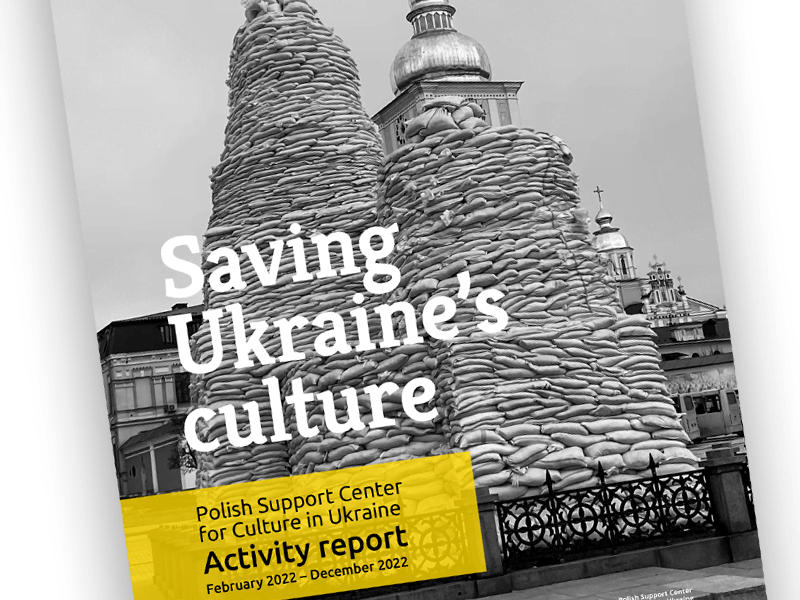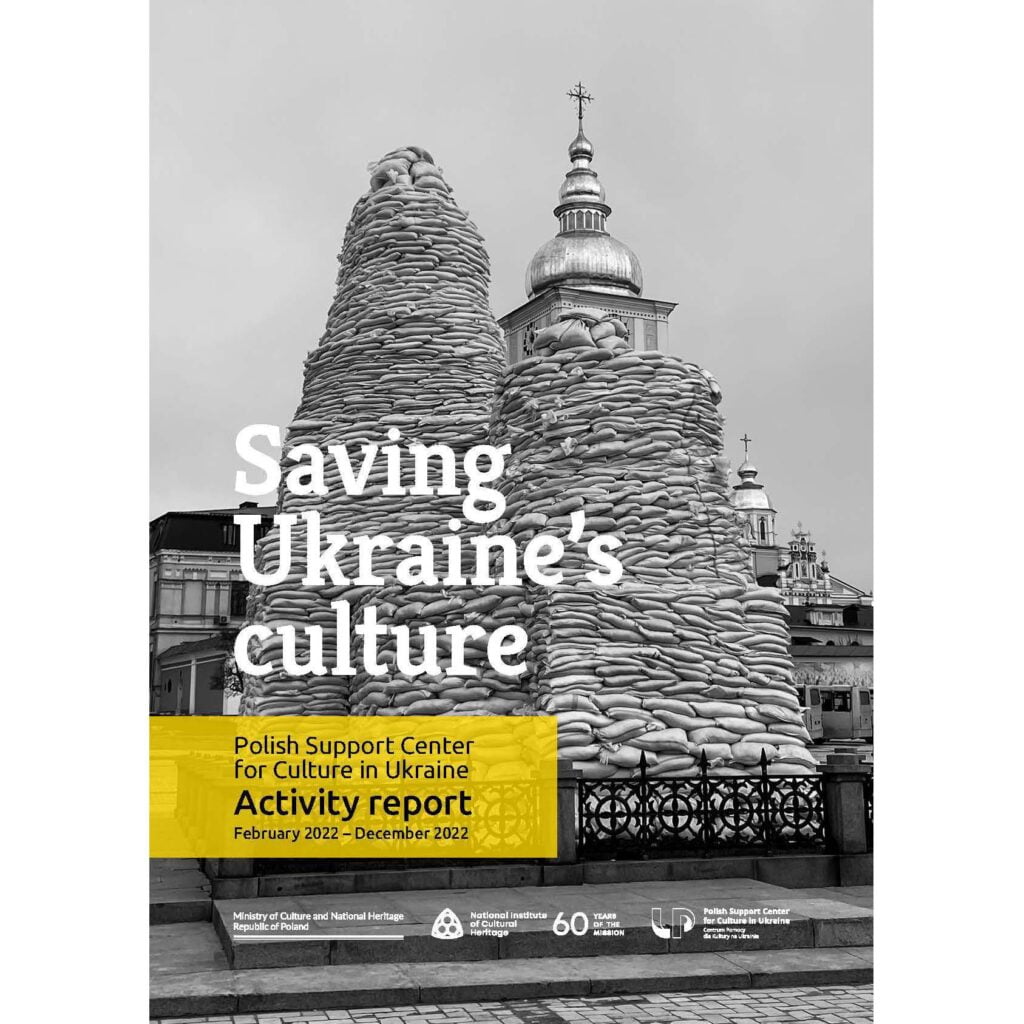The report entitled ”Saving Ukraine’s culture” has been developed to summarise the activities conducted by the Support Center for Culture in Ukraine.
Since the beginning of the Russian aggression, the National Institute of Cultural Heritage has been actively involved in the protection of cultural heritage in Ukraine. Pursuant to the decision of the Ministry of Culture and National Heritage, the Support Center for Culture in Ukraine functions within the structure of the Institute, as the primary coordinator of the governmental aid for Ukraine’s cultural center. The Center coordinates (Polish and foreign) initiatives to save Ukraine’s cultural resources and conducts information and educational activities on Ukraine’s cultural heritage, focusing on the threats and losses resulting from the armed activities. It cooperates with Polish cultural institutions, museums, state archives and libraries, monument conservationists, and other institutions.
The Institute’s experience and the years-long Polish-Ukrainian cooperation have provided the foundation for the efficient support of Ukraine’s cultural heritage since the first day of the war. The Institute supports Ukraine in front of international organisations, especially regarding the dissemination of the news and the evidence of the intentional destruction of Ukraine’s cultural heritage. In cooperation with UNESCO and other international organisations, the National Institute of Cultural Heritage also initiates new endeavours in support of Ukraine’s cultural heritage.
Since the first days of the war, deliveries of targeted material support have been sent directly to cultural institutions in Ukraine. These are mostly museums, but also cultural reserves, libraries, archives, and places of worship. Thanks to the close cooperation with the Ukrainian side, and especially with the Ministry of Culture and Information Policy, 111 institutions received support in the year 2022 through the intermediary services of the Center. More deliveries are in the pipeline due to the active involvement of many Polish and foreign institutions, including the Polish Governmental Agency for Strategic Reserves. The scale of our aid is tremendously significant – to date, our state has donated EUR 2 million for this purpose.
Yet, each shipment is a separate story when a portion of Ukraine’s and Europe’s heritage is successfully saved for future generations. Our report not only describes the aid efforts; its primary aim is to enhance the awareness of the threat posed by the strategy of the purposeful and systematic destruction of Ukraine’s culture, which Russia is applying. In Poland, we fully comprehend the tragic consequences of such actions for the society’s development and identity. In other countries, the crucial point is sadly being missed that the war in Ukraine is primarily a struggle in defence of our common European values and culture against Russian barbarism. We hope that the examples of the destruction presented in this report – which regard numerous architectural and religious monuments, archaeological sites, as well as intangible heritage items – will convince our readers abroad of the nature of deeds perpetrated by the Russian military, having the characteristics of war crimes.
The report has been developed in the English language. It is one of the first studies to comprehensively address the issue of cultural heritage destruction and point to the need for the international community to protect culture in armed conflicts effectively.
What are the essential aid activities performed by the Center?
The Support Center for Culture in Ukraine is the primary coordinator of Polish and international efforts aimed at delivering material aid to cultural institutions in Ukraine. Apart from that, the Center’s staff perform expert activities in close cooperation with partners in Ukraine, as well as within international organisations. We opened the year with the premiere of the film Erase the Nation, directed by Tomasz Grzywaczewski, which complements the report to present a shocking image of the destruction. Also in January, in cooperation with UNESCO, we organised a regional training workshop on countering the illegal export of historical monuments from Ukraine.
Last year, we organised training workshops on the use of modern technologies in the conservation and documentation of monuments, as well as a conference on the Warsaw Recommendation on Recovery and Reconstruction of Cultural Heritage. This document was created on the initiative of Poland in 2018 and provides a set of principles relating to the reconstruction and restoration of monuments destroyed as a result of armed conflicts or natural disasters. It could be used as key guidelines for the reconstruction process that Ukraine will have to undertake. The text of the Warsaw Recommendation is available in five languages, including Ukrainian. In addition, we have published a report on the protection of the intangible heritage of Ukrainian refugee communities in Poland.
Our activities and involvement would not have been possible without the vast knowledge and commitment of the staff of the National Institute of Cultural Heritage. In Poland, we do have top experts in the fields of digitisation, restoration of monuments, and protection of heritage in armed conflict, some of whom took part in the missions in Iraq and Afghanistan.
What do we know about the destruction of culture in Ukraine?
At this point, various statistics on the damage are available. We must bear in mind that in wartime conditions, verification of information often requires more time and effort. In the report, we refer to the data presented by the Ministry of Culture and Information Policy of Ukraine. According to the information, as of 13 December 2022, we knew about 553 destroyed objects but the official records dated 25 January 2023 already gave the number of 1 271 objects. The Russian troops are, in an organised manner, involved in the theft of museum objects, robbery of archaeological sites, and destruction of buildings important for local communities, including libraries, archives, and religious sites.
The Scythian gold collection was stolen from the Melitopol Museum, almost the entire collection of the Oleksiy Shovkunenko Museum in Kherson was taken away. In Izium, Russian troops destroyed medieval stone statues, using a nearby natural monument and a memorial to World War II victims as firing positions. The heritage of the Crimean Tatars is under particularly aggressive attack, with plaques of World War II victims destroyed in the village of Orlovka. Many wooden Eastern Orthodox and other churches have disappeared irretrievably. The Jewish cemetery in Gluchow was devastated, as was the memorial to Holocaust victims in Babi Yar. Paintings by Maria Prymachenko, a leading primitivist artist drawing on folk art, were burnt down in February 2022 by shelling at a historical museum in Kyiv. In the center of Luhansk, a plaque appeared on a monument to Taras Shevchenko faking this Ukrainian poet as a ‘Russian artist’. We also know that many artists and cultural people have died at the hands of the Russians. We see war crimes in Ukraine – the results of the Kremlin’s policy of falsifying history against the independent and sovereign Ukrainian people and their culture.
Pobierz/Download/Завантажити:


